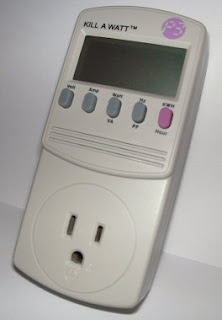I bought the gadget pictured here back in 2007:

It’s called the Kill A Watt. (Details here.) If you’ve ever wondered how much juice a given household appliance sucks, then you need one of these.
Simply plug it into the wall, and then plug into it whatever appliance you want to measure. The display shows a variety of information, including the number of watts being drawn, the voltage, etc.
I find the most useful reading to be kWh, or “kilowatt-hours”. My electrical utility bills me by kWh used, so I can directly correlate a given household appliance to dollars and cents. Knowing this information, I can take action, such as replacing the appliance, using it less often, or keeping it unplugged when not in use. The Kill A Watt has a built-in timer that starts counting from when you plug it in, so checking the length of time it took for an appliance to draw the amount of energy reported is easy as well. Knowing that, it is straightforward to estimate monthly or annual usage.
I’ve also used it to measure multiple devices at once. For instance, my household network is a mish-mash of broadband modems, routers, switches, and servers. Most of that is serviced by two uninterruptible power supplies. Instead of measuring each device alone, I plugged each UPS into the Kill A Watt. Now I know how much money I’m spending on keeping a good chunk of my network powered 24 hours per day. I’ve also measured how much energy is consumed by our home entertainment system — while that isn’t on 24 hours per day, sometimes we get close! (Darn PVR :-)
One thing I haven’t been able to do yet is measure the energy consumed by the biggest appliances in the house: the furnace fan, the air conditioner, the clothes dryer, the range, the oven. These are either wired direct to the panel or don’t use standard outlets, since each requires a lot of juice. The best I’ve been able to do is guess based on research of similar appliances. I wish these all had stickers or information in the manual showing average and peak consumption, but they don’t. Theoretically, I could measure each by turning off everything else in the house at the electrical panel, and then checking the utility’s meter outside, but I think inconveniencing the household like that would be a little nutty!

Comments on this entry are closed. If you have a question about this post, please contact me.